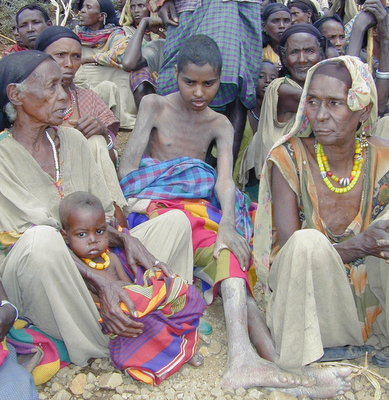Disaster Looms: Millions More Ethiopians Face Hunger
( Dont be too lazy to read this artical)

The UN World Food Programme on Tuesday urged an immediate response to head off a massive humanitarian crisis in Ethiopia because the number of people in need of food aid is expected to rise sharply from the current 6 million to between 10 to 14 million people next year.
"The number of people requiring food assistance in 2003 will depend on this month's rainfall. If the rains stop early, 14 million people will need food aid, but even if they continue as normal, 10 million people will still need relief supplies," said Georgia Shaver, WFP Representative in Ethiopia.
"These figures are staggering and the international community should be prepared to face the worst-case scenario which will require between one to two million tonnes of food aid. If donors respond quickly, we can help avoid immense human suffering in Ethiopia, " she said.
Recent joint WFP, donor and government assessment missions across the country reveal widespread losses of maize and sorghum crops as well as further reduced sources of pasture and water. The drought has caused numerous livestock deaths, with remaining animals only just surviving. Particularly affected are the pastoralist region of Afar, eastern parts of Oromiya Region lowlands, several areas of the Southern Nations, Nationalities and Peoples Region and northern Somali Region.
Due to drought and erratic rainfall, many pastoralists and farmers face ashortage of livestock products and a lack of green harvest of maize and sorghum, which are harvested green and are an important lean season food. These are also the staple foods for most rural people - accounting for over 40 percent of the total cereal production in Ethiopia. Nutritional surveys in several regions of Ethiopia are already showing increased cases of malnutrition among the weak and vulnerable.
"We have started distributing food in affected areas early enough to contain the crisis, but if we don't get more pledges quickly, aid agencies' relief stocks will run out before December and the situation will deteriorate rapidly," said Georgia Shaver.
On 7th October, the national Disaster Prevention and Preparedness Commission launched an urgent appeal for food for some seven million people during October - December. For the remainder of the year Ethiopia needs 273,000 tonnes of food.
The United States, the European Union, Sweden, China, Italy and Germany have already announced contributions totalling 200,000 tonnes.
Besides food required until the end of the year, WFP is also seeking funding as soon as possible to cover the needs for the first quarter of 2003, estimated at between 350,000 - 500,000 tonnes (US$150 million to US$200 million). Timely donors' pledges are vital so that food aid shipments are scheduled to match the food requirements through the year.
So far in 2002, WFP has received contributions totalling 300,000 tonnes of food (US$130 million), to feed approximately three million people per month in Ethiopia. Beneficiaries receive basic food rations consisting of cereals while the most vulnerable groups, children under five, pregnant and nursing mothers, the sick and the elderly ? receive supplementary rations of enriched blended foods. (WFP press release)

The UN World Food Programme on Tuesday urged an immediate response to head off a massive humanitarian crisis in Ethiopia because the number of people in need of food aid is expected to rise sharply from the current 6 million to between 10 to 14 million people next year.
"The number of people requiring food assistance in 2003 will depend on this month's rainfall. If the rains stop early, 14 million people will need food aid, but even if they continue as normal, 10 million people will still need relief supplies," said Georgia Shaver, WFP Representative in Ethiopia.
"These figures are staggering and the international community should be prepared to face the worst-case scenario which will require between one to two million tonnes of food aid. If donors respond quickly, we can help avoid immense human suffering in Ethiopia, " she said.
Recent joint WFP, donor and government assessment missions across the country reveal widespread losses of maize and sorghum crops as well as further reduced sources of pasture and water. The drought has caused numerous livestock deaths, with remaining animals only just surviving. Particularly affected are the pastoralist region of Afar, eastern parts of Oromiya Region lowlands, several areas of the Southern Nations, Nationalities and Peoples Region and northern Somali Region.
Due to drought and erratic rainfall, many pastoralists and farmers face ashortage of livestock products and a lack of green harvest of maize and sorghum, which are harvested green and are an important lean season food. These are also the staple foods for most rural people - accounting for over 40 percent of the total cereal production in Ethiopia. Nutritional surveys in several regions of Ethiopia are already showing increased cases of malnutrition among the weak and vulnerable.
"We have started distributing food in affected areas early enough to contain the crisis, but if we don't get more pledges quickly, aid agencies' relief stocks will run out before December and the situation will deteriorate rapidly," said Georgia Shaver.
On 7th October, the national Disaster Prevention and Preparedness Commission launched an urgent appeal for food for some seven million people during October - December. For the remainder of the year Ethiopia needs 273,000 tonnes of food.
The United States, the European Union, Sweden, China, Italy and Germany have already announced contributions totalling 200,000 tonnes.
Besides food required until the end of the year, WFP is also seeking funding as soon as possible to cover the needs for the first quarter of 2003, estimated at between 350,000 - 500,000 tonnes (US$150 million to US$200 million). Timely donors' pledges are vital so that food aid shipments are scheduled to match the food requirements through the year.
So far in 2002, WFP has received contributions totalling 300,000 tonnes of food (US$130 million), to feed approximately three million people per month in Ethiopia. Beneficiaries receive basic food rations consisting of cereals while the most vulnerable groups, children under five, pregnant and nursing mothers, the sick and the elderly ? receive supplementary rations of enriched blended foods. (WFP press release)


0 Comments:
Post a Comment
<< Home